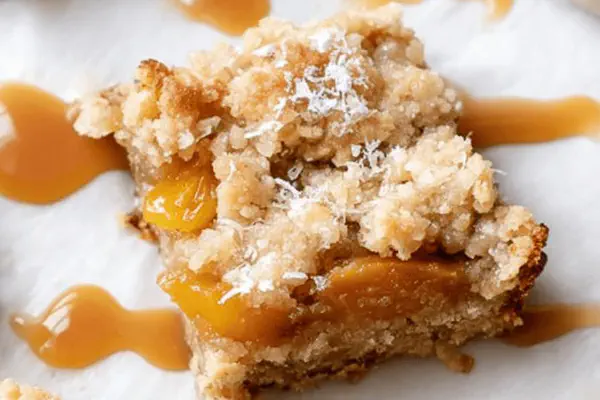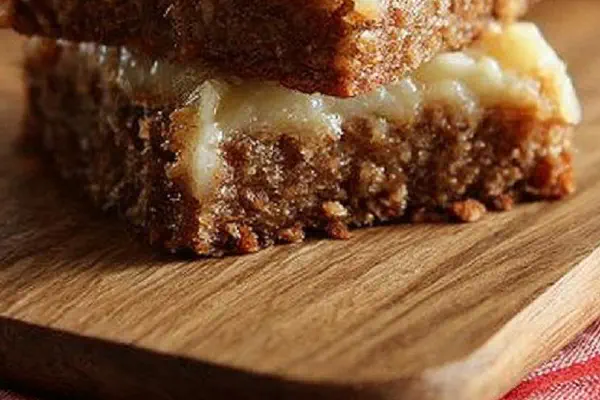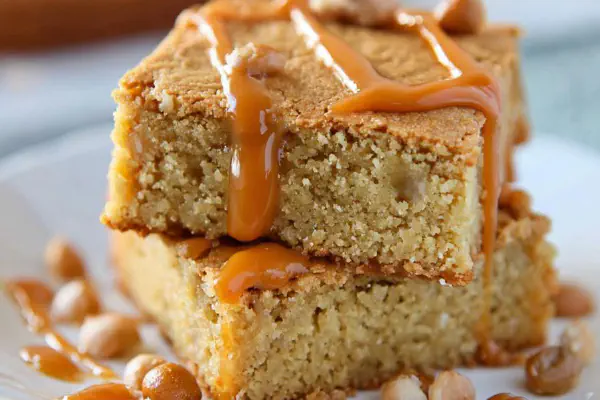Apricot Coconut Bars

By Emma
Certified Culinary Professional
Ingredients
- For the bars
- 9 tablespoons softened butter
- 113 grams granulated sugar
- 1 large egg
- 1 teaspoon pure vanilla extract
- 160 grams all-purpose flour
- 50 grams shredded unsweetened coconut
- 1 teaspoon baking powder
- 3/4 teaspoon ground cardamom
- 1/4 teaspoon salt
- 175 grams apricot preserves
- For the caramel drizzle
- 120 milliliters sweetened condensed milk
- 75 grams light brown sugar
- 2 tablespoons unsalted butter
- 1 teaspoon vanilla extract
About the ingredients
Method
For the bars
- Heat oven to about 345°F. Butter and sugar. Beat until grain fades and mix feels lighter but not fluffy. Egg joins in next, vanilla following like a whisper. Dry stuff sifted or whisked separate: flour, coconut, POWDER, cardamom, salt mixed well until aromatic, nutty, floral. Dump dry into wet; fold gently but fully so no streaks remain. Two thirds pressed firmly into well-greased 8×8 pan, edges packed tight to brown evenly.
- Spread preserves like sticky paint on the crust layer. Crumble leftover batter on top, uneven bits for texture. Watch oven heat: bake around 25-30 minutes but check for golden edges, slightly firm center that jiggles less when nudged. Overbake means dry crumb. Cool fully on rack—patience is a virtue; bars fall apart hot.
For the caramel drizzle
- Small saucepan, medium flame. Combine condensed milk and brown sugar first—stir slowly until bubbling simmers, about 1 1/2 to 2 minutes tops. Remove from heat or risk burn and bitter finish. Butter folds in quick, melting silky smooth. Vanilla in last, off flame to keep fragrance fresh and bright.
- Drizzle warm, not hot, over bars before slicing; caramel sets quickly, glossy and thick. Bars hold shape best cooled; warm caramel seeps if sliced too early.
- Keep bars airtight or caramel gets sticky and grainy over time.
- Enjoy the crackle when biting; chew from coconut, tartness from fruit, warmth from cardamom, sweetness from caramel.
- Common swap: margarine or coconut oil for butter in crust. Coconut oil lends tropical note but skip if you want traditional texture. Orange marmalade trades apricot preserves for more bitter complexity.
- Visual cues trump timers always. Top golden, no wet dough spots. Caramel bubbling gently, no rapid boil. Texture speaks: firm base, soft middle, chewy edge.
- If crust crumbles too much, press more firmly or chill dough briefly before baking. If caramel too thin stir longer or reduce sugar slightly.
- Don’t rush cooling or slicing; slice warm bars and caramel runs all over pans. Chill 45-60 minutes until firm but not cold hard.
- Experiment with adding chopped almonds to crumble layer for crunch or swapping cardamom with cinnamon for autumn vibes.
Cooking tips
Chef's notes
- 💡 Butter and sugar beaten until grainy texture fades—look for mixture lighter, thick but not airy. Egg added slowly with vanilla extract to avoid curdling. Dry ingredients sift separately to avoid lumps and ensure even cardamom dispersion. Folding dry into wet, no whipping; keep batter tender. Press two thirds firmly in pan, edges tight to brown evenly without gaps or too-thick patches. Uneven pressing leads to breakage or uneven bake.
- 💡 Apricot preserves spread like thick paint, avoid thin layers that dry out or create soggy spots. Use leftover batter crumbled on top for chewy contrast, no even layer here; uneven bits build texture. Baking timing not strict; watch edges golden honey tone and jiggle in center, not liquid. Oven hotspots shift times—rotate pan halfway for uniform crust color and caramel consistency.
- 💡 Caramel drip made by simmering condensed milk gently—avoid full boil or bitterness. Stir brown sugar slowly to dissolve, bubbles just starting. Off heat fold in butter for smooth, glossy texture, add vanilla last to keep aroma bright. Warm caramel only on bars; hot caramel melts crust and seeps. Wait 10-15 minutes for caramel to set. Too thin? Simmer longer but watch closely or it thickens and grainy.
- 💡 Switch butter in crust to coconut oil for tropical aroma; expect crumb to soften slightly, less crisp. Margarine works but changes mouthfeel. Orange marmalade swaps apricot preserves; sharper, more bitter edge—adjust sugar if needed. Fresh ground cardamom essential; stale powder dulls floral notes, pods grind better. If coconut too moist add to dry mix after toasting lightly in dry skillet for nutty smell and toothsome crunch.
- 💡 Cooling crucial; cool fully on wire rack, hot bars crumble and stick. Slice after caramel firms to avoid sticky mess; too soon caramel runs and softens edges. If crust crumbly, press dough more firmly or chill briefly before bake. Texture relies on feel, not timer—use sight, touch, and smell; caramel bubbling slows when ready. Chopped almonds or cinnamon instead of cardamom add crunch or warm spicy twist. Timing flexible; trust cues over minutes.
Common questions
How do I know when bars are done?
Look edges golden honey, center jiggles less but not rigid. No wet spots on top. Texture speaks: firm base, soft middle, chewy edges. Watch caramel bubble slow, no rapid boil or burnt smell. Oven varies. Rotate pan, trust sight and feel over time.
Can I swap apricot preserves?
Yes, orange marmalade sharper, peach jam sweeter. Each changes tart balance and texture. Adjust sugar if marmalade’s bitter. Mixing preserves into batter loses fruit layer effect—spread thick for contrast or crumble texture. Fresh preserves better; store-bought can be watery, thin layers risk soggy crust and drying middle.
Why is caramel thin or grainy?
Often due to overcooking or too rapid boil causing burnt flavor. Simmer gently, stir slowly until bubbles just start. Off heat fold in butter and vanilla right away to emulsify. Too thin? Simmer longer but watch. Too thick? Add splash milk off heat stir; graininess means phase separation from fat and sugar. Use butter, oil may separate.
Best way to store bars?
Airtight recommended to prevent caramel grain and crust softening. Room temp short-term fine if cool and covered. Refrigerate to prolong but caramel firms more; warming bars before serving loosens texture. Freeze wrapped tightly then thaw in fridge overnight. Keep caramel warm or it sticks; cool bars hold shape better for slicing.



